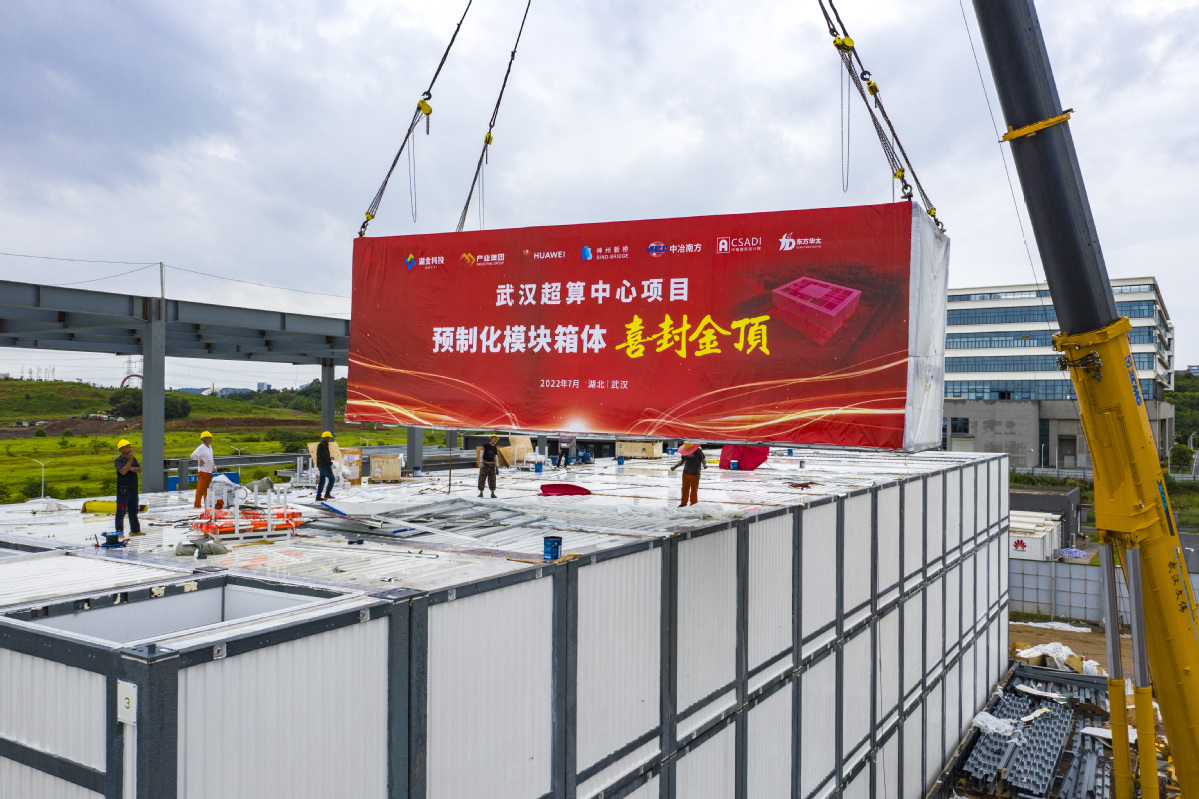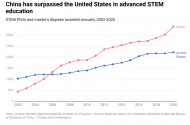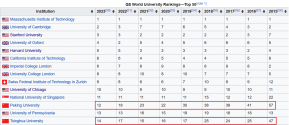broadsword
Brigadier
Someone here brought up applications in construction divorced from what the original link discussed.
I know.
Someone here brought up applications in construction divorced from what the original link discussed.

Wuhan center to enhance country's supercomputing fortitude, acumen
By CHENG YU in Beijing and LIU KUN in Wuhan | China Daily | Updated: 2022-08-17 09:35
The Wuhan Supercomputing Center, China's largest container-like computing facility, is close to completion in Wuhan, Hubei province. [Photo by WEI LAI/FOR CHINA DAILY]
In a world where computing power may become the next strategic competition area, the Wuhan Supercomputing Center, China's largest container-like computing facility, was recently officially connected to the national computing network and is in its final launching stage.
Located in Central China's Hubei province, the landmark center will offer computing power of 50 petaflops in the initial stage, which is equivalent to 100,000 high-performance computers operating simultaneously, and is expected to eventually provide 200 pflops in total. Computing power roughly refers to the ability to process data.
The center has already been connected to the China Computing NET, or C2NET-a major national computing cluster that links supercomputing networks and artificial intelligence data centers across the country, including those in cities like Beijing, Xi'an, Nanjing and Qingdao.
"The move is a big step forward for the country's east-data-west-computing project. By leveraging local prowess in distributed computing, mass storage, AI computing power platforms and big data, the center will significantly drive computing power nationwide," said Feng Dan, a professor at the School of Computer Science and Technology, Huazhong University of Science and Technology.
The east-data-west-computing project involves China sending data gathered from the more prosperous eastern regions of the country to less-developed but resource-rich western regions for storage, calculation and feedback, which aims to help the country improve imbalances in the layout of digital infrastructure and maximize the value of data in a more productive way.
Although a late entrant to the high-performance computing field, China now tops the world with around 35 percent of the world's top 500 most powerful supercomputers and is quickly building a network of national supercomputing centers, where people can use computing power just like water and electricity.
The country's 14th Five-Year Plan (2021-25) also spelled out plans to construct 10 exascale computing systems by the end of 2025.
"China already surpassed the United States in AI computing power last year. I believe that in less than a year or two, the nation's overall computing power will exceed that of the US," said Wu Hequan, an academician at the Chinese Academy of Engineering.
"With more joint efforts in building supercomputer centers and networks, computing power will become the next new engine of the country's digital economy and further economic development," Wu said.
The Wuhan Supercomputing Center also adopted a new way of using container-like modular prefabricated boxes with integrated circuits and pipes laid in the box prior to being joined together, which shortens construction periods by one-third.
武汉超算中心首期算力将达到50P,整体按照200P算力进行规划设计,是光谷科学岛起步区的引爆项目。武汉超算中心负责人罗庆介绍,50P算力,相当于10万台高性能计算机的算力,其技术底座是由数万核鲲鹏处理器内核以及数千张加速卡构成。
武汉超算中心结构形式为预制模块化集成安装和钢结构两部分,其中数据机房部分采用预制模块化集成安装。
罗庆介绍,中心采用预制模块化箱体建设,共61个预制化模块箱体,每个箱体长约12.2米,宽约3.5米,高约4.2米,拼装时分为三层,每层约20个箱体。
为何选择集装箱形式修建?中心相关负责人龚正介绍,该中心采用华为公司的预制模块化集成安装,箱体设计时,已将所有设备、桥架、管线等内容进行落位设计,建立BIM模型,将有干扰的地方进行模拟预设,达到最优配置。集装箱生产过程中做好相应预留。同时,项目土建和设备集成安装同时进行,大大缩减建设周期。
龚正说,华为以庞大技术团队为支撑,在集装箱集成解决方案上走在全国前列,这些方案与传统建设模式相比减少了后期落位、优化、再落位的工序,作为全国首个预制模块化超算中心建设项目,他们正在和华为一起探索这种建设模式。未来,随着BIM模式成熟,数据中心会更多采用集装箱模式安装。
This tweet is misleading in saying that the satellite "will be used for origin-tracing of infectious diseases, analyzing endemic diseases, etc."
据悉,该卫星设计载荷重约50公斤,装备可见光高光谱相机、紫外相机等,兼具高光谱、微光、紫外等多模式,将重点围绕中国、兼顾周边国家,探测影响人类健康的环境因子,服务于传染病溯源、地方性疾病分析、健康长寿因子监测、灾后疫情防控、公共疾病传播与预防等领域。
龚健雅介绍,该卫星将研制多传感器载荷卫星平台,将针对影响人类健康的“水-土-气”环境要素探测设计载荷与选择波段,提升全球健康研究领域遥感监测能力;将把健康、人口和环境数据联系起来,开展医学遥感应用示范。
The Japanese study about the most highly cited papers (top 1%) that was discussed earlier... here's the rankings.
We make fun of India a lot, but they are indeed rising. I'm surprised to see Spain above Japan.
Spain did very poorly on AI paper representation, so I would assume a lot of these papers are in fields like biology etc.
Italy as usual outperforming expectations.
View attachment 95534
Incorrect. The Japanese study tracks both measures.The Japanese study is about top 10%, not top 1%.
According to an annual report by the Japanese government, for the first time China is now leading the world in the three key stats of scientific papers in the fields of natural science: total number of papers published, number of papers in the top 10% of most cited citations, and number of papers in top 1%. The US was the only country that had owned all the three key stats before.
Last year China had published 25% of the top 1% papers, approaching to the US which had 27%. This year China has 4744 papers, or 27.%, in the top 1% category while the US has 4330, or 24.9%.
The Nikkei Asia piece is paywalled. Here is the Chinese translation by Guancha:



It'd be interesting to look at the more recent data. It's quite likely to have changed dramatically, considering the # of Chinese young adults that are still looking to study in the US has already dropped significantly.A critical aspect of China-US competition will be STEM talent. I don't think most people - including most Americans - understand just how dependent the US is on foreign talent to fuel its tech ecosystem.View attachment 95669
China has surpassed the US in STEM graduates years ago - and the gap is growing.
View attachment 95670
International co-operation is good for China, but losing talent isn't. The good news is that fewer Chinese top students go abroad (and even among those who go, many come back), this will be a major problem for the US going forward. China should make studying abroad harder, especially as Chinese universities are becoming better and better.
Just look at how Tsinghua and PKU have improved in the past few years.
View attachment 95671
This trend of improvement is similar for other Chinese universities. It should help alleviate emigration pressure of the brightest talents.
The photo you uploaded titled "Highly cited scientific papers country ranking" is about top 10%.Incorrect. The Japanese study tracks both measures.
